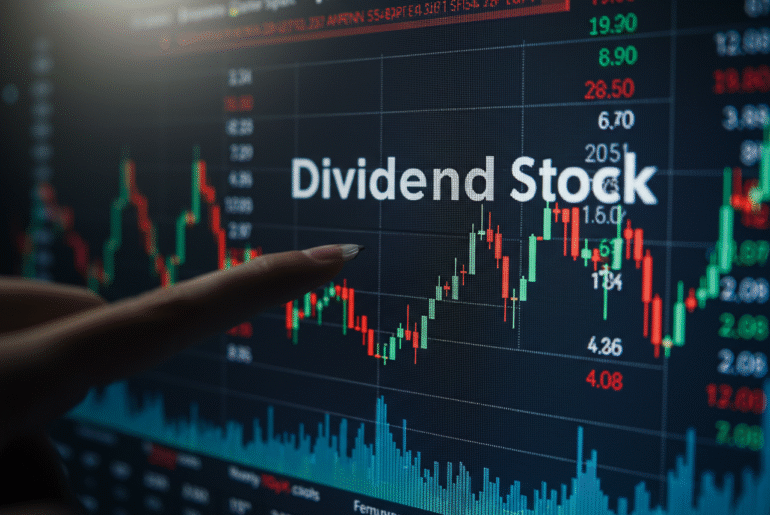This article may contain references to products or services from one or more of our advertisers or partners. We may receive compensation when you click on links to those products or services. Nonetheless, our opinions are our own.
The information presented in this article is accurate to the best of our knowledge at the time of publication. However, information is subject to change, and no guarantees are made about the continued accuracy or completeness of this content after its publication date.
- Introduction to Dividend Stocks in 2025
- Dividend Yield
- Top High-Yield Dividend Stocks for August 2025
- Dividend Stocks Versus Dividend Funds
- Matching Dividend Stocks to Risk Profiles
- How to Begin Dividend Investing
- Final Thoughts on Dividend Stocks in August 2025
- Frequently Asked Questions
- Recommended Reads
Introduction to Dividend Stocks in 2025
In 2025, dividend stocks are attracting renewed interest as interest rates begin to decline. Investors are focusing on income-generating assets that also provide long-term growth potential. Dividend stocks offer two main advantages: consistent income through regular payouts and potential capital appreciation as strong companies increase in value. Selecting safe dividend stocks requires attention to stable earnings, reasonable payout ratios, and a history of consistent payments. This balance helps investors achieve both income and growth goals.
Dividend Yield
Dividend yield is calculated by dividing the annual dividend by the share price. For example, if a stock trades at $30 and pays a $2.40 annual dividend, the yield is 8%. However, a high yield is valuable only if the company can sustain it. Investors should prioritize companies with strong free cash flow and healthy earnings to ensure dividend reliability. Evaluating these factors helps avoid risks associated with unsustainable dividend payouts.
Top High-Yield Dividend Stocks for August 2025
1. Pioneer Natural Resources (PXD)
Dividend Yield: 8.5%
Sector: Energy (Oil & Gas)
Pioneer benefits from strong oil prices and prudent capital management. Its variable dividend model allows flexibility based on profitability. Investors should be aware of volatility in oil prices affecting earnings.
2. Altria Group (MO)
Dividend Yield: 8.2%
Sector: Consumer Staples (Tobacco)
Altria has a long-standing history of dividend reliability. The company is expanding into non-combustible products and nicotine alternatives despite declining smoking rates. Regulatory risks and changing consumer behavior remain factors to watch.
3. Verizon Communications (VZ)
Dividend Yield: 7.4%
Sector: Telecommunications
Verizon’s large subscriber base, strong brand, and solid cash flow support its dividend. Ongoing 5G infrastructure investments are expected to drive future growth. Competition and capital expenditures may impact results.
4. Enterprise Products Partners (EPD)
Dividend Yield: 7.2%
Sector: Energy Infrastructure (Pipelines)
EPD generates steady revenue through long-term contracts. Its MLP structure offers attractive yields but includes tax complexities. Lower energy throughput during economic slowdowns may affect earnings.
5. OneMain Holdings (OMF)
Dividend Yield: 6.8%
Sector: Financials (Consumer Lending)
OneMain serves middle-income borrowers with strong underwriting practices. Its dividend reflects confidence in loan performance and profitability. Increased defaults during economic downturns present risks.
Voted "Best Overall Budgeting App" by Forbes and WSJ
Monarch Money helps you budget, track spending, set goals, and plan your financial future—all in one app.
Get 50% OFF your first year with code MONARCHVIP
Dividend Stocks Versus Dividend Funds
| Feature | Individual Stocks | Dividend Funds |
|---|---|---|
| Control | Full control over holdings | Managed by professionals |
| Risk | Higher (concentrated bets) | Lower (diversified exposure) |
| Yield Potential | Higher with careful selection | Generally moderate |
| Effort Required | More research and monitoring | Minimal involvement |
Matching Dividend Stocks to Risk Profiles
Low-risk investors should focus on stable sectors such as telecommunications or utilities. Those seeking higher yield potential might consider cyclical sectors like energy or consumer lending. Immediate income seekers benefit from stocks with proven dividend records. Long-term investors may prefer companies with a history of growing dividends. Defensive investors often choose consumer staples, which tend to perform better during recessions. Economic rebounds typically favor energy and financial stocks.
How to Begin Dividend Investing
Start by opening a brokerage account on trusted platforms like Fidelity, Schwab, Robinhood, or M1 Finance. Use a stock screener to filter for high yield, low payout ratios, and positive earnings trends. Begin investing gradually to manage risk. Enable Dividend Reinvestment Plans (DRIPs) to automatically reinvest dividends for compounded growth. Review your portfolio annually to rebalance and replace underperforming stocks.
Final Thoughts on Dividend Stocks in August 2025
Dividend stocks continue to be an attractive option for income-focused investors in August 2025. The highlighted stocks, Pioneer Natural Resources, Altria Group, Verizon Communications, Enterprise Products Partners, and OneMain Holdings, offer strong yields supported by resilient business models. A well-constructed dividend portfolio can balance income needs with growth potential. By understanding sector dynamics and company fundamentals, investors can navigate opportunities and risks effectively. Regular portfolio reviews and reinvestment strategies further enhance long-term returns.
Frequently Asked Questions
What sectors are safest for dividend investing?
Utilities, telecommunications, and consumer staples are generally considered more stable for dividend investing. These sectors tend to have steady cash flows and less sensitivity to economic cycles. They offer reliable income and are often favored during uncertain market conditions. However, investors should still evaluate individual company fundamentals within these sectors.
What is considered a healthy payout ratio?
A payout ratio under 70% is often regarded as healthy, indicating the company retains enough earnings to sustain dividends. Some sectors, like REITs and MLPs, may have higher payout ratios due to their business structures. Investors should analyze payout ratios in the context of industry norms and cash flow stability to assess dividend safety.
How often are dividends paid?
Most U.S. companies pay dividends quarterly, providing regular income to investors. Some firms may pay monthly dividends, while others distribute them annually or semi-annually. The payment schedule can affect cash flow planning for income-focused investors. It is important to check the dividend payment calendar of each company.
Can a company cut its dividend?
Yes, companies can reduce or suspend dividends if earnings decline or debt levels increase. Dividend cuts often signal financial stress and may lead to stock price declines. Investors should monitor company performance and broader economic conditions to anticipate potential dividend changes. Maintaining a diversified portfolio helps mitigate risks from dividend cuts.
Are dividends taxable?
Dividends are generally taxable income. Qualified dividends are taxed at capital gains rates, which are lower than ordinary income tax rates. Non-qualified dividends are taxed at ordinary income rates. Tax treatment varies depending on individual circumstances and holding periods. Consulting a tax advisor can help optimize tax efficiency.
Should dividends be reinvested?
Reinvesting dividends through DRIPs can accelerate portfolio growth by compounding returns over time. This strategy allows automatic purchase of additional shares without fees. However, investors may also choose to take dividends as cash for income needs. The best approach depends on personal financial goals and cash flow requirements.

Reviewed and edited by Albert Fang.
See a typo or want to suggest an edit/revision to the content? Use the contact us form to provide feedback.
At FangWallet, we value editorial integrity and open collaboration in curating quality content for readers to enjoy. Much appreciated for the assist.
Did you like our article and find it insightful? We encourage sharing the article link with family and friends to benefit as well - better yet, sharing on social media. Thank you for the support! 🍉
Article Title: 5 Best High Yield Dividend Stocks August 2025
https://fangwallet.com/2025/08/09/5-best-high-yield-dividend-stocks-august-2025/The FangWallet Promise
FangWallet is an editorially independent resource - founded on breaking down challenging financial concepts for anyone to understand since 2014. While we adhere to editorial integrity, note that this post may contain references to products from our partners.
The FangWallet promise is always to have your best interest in mind and be transparent and honest about the financial picture.
Become an Insider

Subscribe to get a free daily budget planner printable to help get your money on track!
Make passive money the right way. No spam.
Editorial Disclaimer: The editorial content on this page is not provided by any of the companies mentioned. The opinions expressed here are the author's alone.
The content of this website is for informational purposes only and does not represent investment advice, or an offer or solicitation to buy or sell any security, investment, or product. Investors are encouraged to do their own due diligence, and, if necessary, consult professional advising before making any investment decisions. Investing involves a high degree of risk, and financial losses may occur including the potential loss of principal.
Source Citation References:
+ Inspo
There are no additional citations or references to note for this article at this time.












































